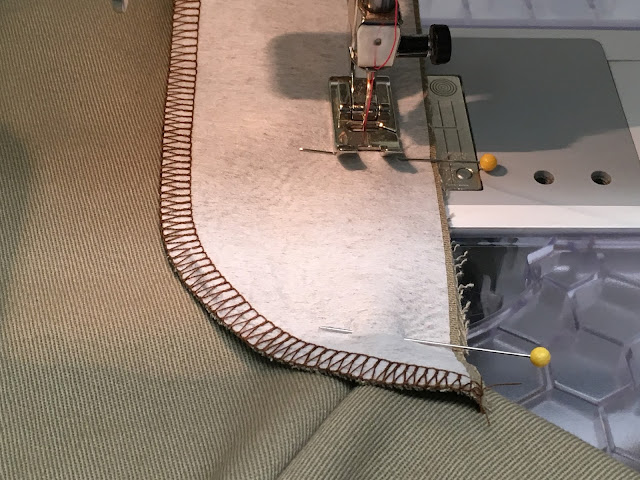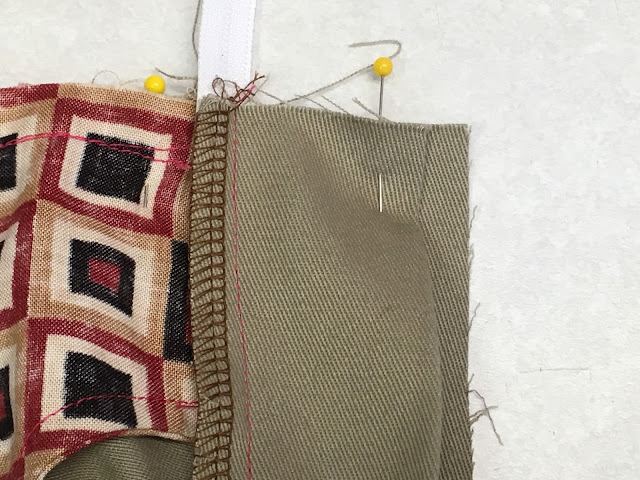Simplicity 2562 Pant -- Amazing Fit
LAYOUT
Lay out all pattern pieces for pants on the fashion fabric. These include pant front, pant back, left front waistband, right front waistband, back waistband, pocket facing and pocket yoke.
Also cut out fly and underlap (fly shield).
Cut front yoke and pocket and pocket lining pieces out of lining fabric.
MARKING
Transfer all markings to wrong side of fabric, including darts, notches, and circles.
If your center back seam is more than 5/8" seam allowance, transfer that marking as well.
Markings on wrong side of fabric. Remove all pattern pieces.
PANTS FRONT
Staystitch 1/2" from edges of pant front waists, stitching from side to center. Also staystitch front crotch seam 1" above and below circle marking, 5/8" from edge.
Pin pant front pieces together and stitch from circle marking to notch marking.
Clip to stitching on right front pant at circle marking.
Staystitch the waist of pocket pieces and front yoke pieces.
POCKETS
Serge raw edges of yoke pieces.
Serge raw edges of pocket facings.
Place pocket lining pieces right side up. Place pocket facing pieces right side up on top of pocket lining pieces, match notches and pin together.
Stitch together on serged edge, and baste together the other edges.

Place front yoke pocket pieces right sides up. Place yoke pieces on top with right sides up, matching notches and pinning in place.
Stitch together on serged edge, and baste together the other edges.
Place pant fronts right side up. Place pocket lining on top of pants, right sides down. Pin in place, matching notches, in pocket opening only.
Sew pocket edges together, IN POCKET OPENING ONLY.
Trim and grade seam allowances, IN POCKET OPENING ONLY.
Clip seam allowances. Press seam allowances towards pocket lining.
Decide whether to understitch or topstitch pocket edges. The following pictures are instructions for understitching the pocket facing.
After understitching, fold pocket lining back and press seam edge.

Add clapper tool for crisp edge.
This is what the pocket edge will look like on the right side.

If you want to topstitch pocket edge, first turn pocket lining back, and press on seam edge.

Topstitch pocket edge.
This pocket edge has been topstitched 1/4" from the edge.
Place pocket lining wrong side up.
Add front yoke and pocket piece WRONG side down on top of pocket lining, matching edges and notches. Pin in place. A French seam will be sewn.
Sew 3/8" seam allowance. Trim seam allowance to 1/8".
Turn pocket wrong side out, with right sides together. Press seam edge.
Finish the French seam by topstitching pocket seam 1/4" from edge on the wrong side of the fabric.
Pocket lining edge now has French seam to finish off outside edges.
Turn pants right side up. Match up notches on waist and side seams. Pin in place, keeping fabric smooth. Baste pocket to pants on waist and side seams.
Here is the finished pocket.

FLY ZIPPER
These instructions will be for a right fly zipper.
Make sure marking for fly zipper topstitching is on right side of right pant leg.

Cut out interfacing for fly facing.

Apply interfacing to wrong side of fly facing.

Serge raw edges of fly facing.

Prepare underlap (fly guard) by folding in half, lengthwise, with wrong sides together. Press and serge raw edges. Set aside until later.

Place front pants right side up. Place fly facing right side down, matching up to front crotch, matching circle. Pin in place.

Sew fly facing to right crotch, stopping at circle. TIP: It is actually easier to sew on the pant side so that you can see where your previous stitching ended.

Trim and grade seam allowance.

Press seam allowance towards facing. Understitch fly facing.

With facing out, place zipper on top, with zipper tape right side down. The left edge of the zipper tape meets seam. Pin in place. Make sure that the bottom edge of the left zipper tape is folded up.

Baste together on left edge of zipper tape.

Topstitch on right zipper tape, first stitching next to coil.

Then stitch again next to edge of zipper tape.

Fold back zipper facing and pin through both fabric layers. Baste through all layers next to chalk marking.
Using zipper foot, stitch from fly bottom to top, following chalk line. Do not backstitch at the beginning and leave a thread tail.
Pull thread tails to the back side and tie into knot.
Cut thread tails.
Take out all basting stitches.
On left front, make a 1/4" clip at large dot.
Press under 1/4" above clip and pin.
Open zipper. Pin left front over zipper tape close to the teeth.
Close zipper and check to make sure that everything is smooth.
Baste underlap in place.
Turn pants wrong side up. Place underlap over zipper area, matching serged edge to edge of zipper tape. Pin in place.
Flip pants right side up and transfer pins to right side through all fabric layers. You may hand baste again if desired.
Edgestitch next to zipper teeth, stitching from top to bottom.
Pull thread tails to the back side and tie in knot.
Remove all basting stitches.
Press fly zippper.
Mark where bar tacks should be stitched.
Test out the small zigzag stitch on scrap fabric. I chose 1.4 stitch width and .4 stitch length for the small bar tacks.
Stitch bar tacks in stress areas.
Pull all thread tails to the back side and tie in knots.
PANTS BACK
Staystitch upper edge of back at the waist.

Pin darts with right sides together, fold the fabric through the center of the dart, bringing broken lies and small dots together. (Note, the slim and average pants back will have two darts. The curvy pants back will have four darts for more shape.

Stitch the dart from the wide end to the point. To prevent a "bubble" at the point, when you are 1/2" from the point, shorten stitch length and stitch the last few stitches right on the fabric fold.

Leave thread tails to tie a knot. Do not backstitch at the point.

Press the dart flat along the stitching to meld the stitches.

Then press dart toward the center, pressing over the pressing ham.

TIP: to help prevent an "indent" from the fold of the dart, add an envelope or sheet of paper folded in half and place it between the dart and the pant fabric. Then press the dart to the side.

WAISTBAND
Cut interfacing for front and back waistbands, Trim off 1/2" all around the interfacing.

On the front waistbands, cut the corners diagonally.

Pin fusible interfacing to WRONG side of left front waistband, right front waistband and back waistband sections.
Press interfacing to waistband pieces. it is best to label each of the waistband pieces to avoid confusion.

For fitting purposes, the waistband seams, inseams, and side seams will all be sewn using a long basting stitch.
With RIGHT sides together, pin right front pant to right front waistband, matching centers.
You may notice that the waistband over the underlap may be less than 5/8".

Baste seam at 5/8". Do the same with the left front.

With RIGHT sides together, pin each back pant to each back waistband, matching centers. Baste seams at 5/8".

INSEAMS
With WRONG sides together, pin the right pant front inseam to the right pant back inseam.
Notice that on the pants back, the seam allowance above the notch grades up to 1".

Baste the pants inseam at 5/8", stretching the pants back to fit from notch to crotch area. The pants back seam allowance will extend. This is called the "stride."

Here is the basted inseams.

With RIGHT sides together, pin remainder of crotch seam, matching inner leg seams, small dots and notches.

Baste from notch in front to small dot in back along 5/8" seam line and front small dot to edge of waistband along center back seam line.

With WRONG sides together, pin front to back at side seams, along the 1" seam line, matching waistband seams. If you want to try on the pants before basting the side seams, put the pins parallel to the fabric edge on the 1" seam line, with the pins pointing down. Try on the pants and adjust pins to personal fit.
Otherwise, pin perpendicular to fabric edge.
Baste along the 1" seam line.

FITTING INSTRUCTIONS
Pin up the bottom hem of the pants.
Baste the pockets closed.

Try on the pants and stand in front of a full length mirror. Wear the shoes you would be wearing. Lap right front waistband over left, matching centers and pin in place.
Fit the pants in this order:
- adjust the fit of the waistband
- check the inseams and the side seams
- check the center back seam
SEWING SEAMS
Unpick basting stitching on inseams and side seams.
Sew inseams and side seams with right sides together. Make sure that the waistband seams match at the side seams and center back seam.

Then trim seam allowances to 5/8" and press seams open. Then serge raw edges.
Pin and sew crotch seam.

To reinforce, stitch crotch seam again. Serge raw edges separately.

WAISTBAND
If you made any alterations to the side seams of the pants, remember to do the same amount to your waistband side seams.
Pin back and front waistband facing sections together at notches.

Stitch center back and side seams of waistband facing sections along seam line or newly marked seam line.

Trim seam allowances on waistband facing.

On lower edge of left front waistband facing, reinforce and clip center front marking on lower edge.

Trim off 1/4" off lower edge of waistband facing, beginning at center front of left front waistband facing.

Enclose trimmed lower edge of waistband facing with double fold bias tape for a professional finish. Identify the more narrow side of the bias tape. This side will be sewn to the right side of the waistband facing, stitching on the fold line. Pin single layer of bias tape to RIGHT side of waistband facing.

Stitch bias tape to waistband facing, using the crease as a stitch guide.

Then fold over the double fold bias tape to the waistband facing wrong side and pin in place. Topstitch on the bias tape with the waistband facing RIGHT side up.

With RIGHT sides together, pin facing to waistband, matching centers and side seams. Baste.

Here is what the left center front looks like pinned.

Here is what the right center front looks like pinned.

Starting at left center front, stitch ends and upper edge of waistband.

Here is what the right front side looks like stitched with a little overlap.

Here is what the left front side looks like stitched.


Clip curves.

Press waistband facing and seam allowances away from garment.

Understitch on facing, close to seam edge, as close as possible to the center fronts.

Here is the understitching finished.

Turn facing to inside and press.

Pin facing in place. The lower edge of the waistband facing will extend 3/8" below seam.

Hand stitch waistband facing to the seam allowance, using the hand blind stitch. These stitches will be 1/4" apart. They should not show through to the right side of the pants.
Sew skirt hook closures at small dots at waistband fronts.
HEM
If your pants are more formal, you may want to hand stitch the hem or sew the machine blind hem. For a single fold hem, finish the raw edges with either a serge stitch or hem tape.
If your pants are more casual, you may stitch a double fold topstitched hem. This will enclose the raw edges.
* * * SEW * * * CREATE * * * LIVE * * *
* * *
*
how to sew a fly zipper, fly zipper, sew women's pants, Simplicity 2562 pattern, tailored pockets, tailored pockets with French seams, tailored waistband with bias tape, tailored waistband, fitting pants, fitting trousers, fitting women's pants


























































